Don't wanna be here? Send us removal request.
Text
week1
Lecture:
Key historical development of 19th-20th
Part1 museums 1-3 collect&conserve; display; educate; stimulate; offer expirence
Part2 Collections 4-6 the art or process of collecting objects
Part 3 Curating 6-8 elect items for exhibition
Part4. Professional practices 9-11 behind the scenes conditioning report, management, archivists, conversation…
Museum of nature and hunt Venus; Position of things
Deep Cuts: A response to a short run
www.pantograph.punch.com
Virtual museums exist in electric form on the internet , they rerun dependent upon collections while also bring benefits.
Assessment:
-blog
-curatorail proposal
Week1 reading the history of museums
The thinking within the museum which drives exhibition making is often motivated by funding, is politicized and ideological.
How is the representation of diverse cultures and community groups displayed in a museum?
Models of display:
What is encountered in a display is understood by how it is framed. This are models of display function, they themselves provide context and meaning. Whom determines these?
Prevailing traditions:
The white cube and the black box are modes of display: architectural spaces in which exhibitions are presented to be experienced. But these space also condition experience. These models have also shaped prevailing traditions on the history of art and exhibition design practices.
Independent tasks: Museums: big, small, practical, virtual, real objects, intangible items…
Assignment:
1.Three types of museums I feel interested:
<1>Steampunk HQ:

1.What do they do:
Steampunk HQ is an art collaboration and gallery in the historic Victorian precinct of Oamaru, New Zealand. It celebrates its own industrial take on steampunk via an array of contraptions and sculptures, complemented by audio-visual installations in two darkened rooms and part of the buildings basement.
2.What’s their collection:

Their collection is about steampunk artwork and sculptures. The gallery presents a theme of a dark post-apocalyptic vision of a future "as it might have been". Contraptions and bizarre machinery featuring heavy use of copper, gears, pipes, gas cylinders, as well as an ensemble of skeletal sculptures are lit by flickering lights and accompanied by projectors and background sounds. The two large darkened rooms and part of the basement of the building house a variety of old industrial and medical machines remade into "aetheric" devices. The exhibits include some large machines, such as a steam tractor, periodically emitting steam, and a boat with a grim reaper.
<2>Cancún Underwater Museum:
Museo Subacuático de Arte, known as MUSA, in Cancun, Mexico

1.What do they do:
Cancun underwater museum is an initiative that wished to divert a large group of ocean divers disrupting the balance of underwater fauna in the Caribbean coastline. The director of the Cancun National Marine Park -Jaime Gonzalez Canto wished to provide an alternative to preserving these disrupted coral reefs. By bringing British Sculptor Jason De Caires Taylor and a group of Mexican artists on board, nearly 500 statues with pH neutral marine concrete were anchored into the ocean.
The Cancun underwater museum also known as the ‘Museum of submerged Art’ has nearly three such galleries that showcase a variety of themes reflecting the subtle nuances of the fishing community.The idea of maintaining a much-needed balance between nature and mankind is reinforced through its solitary human sculptures.You can view these underwater installations in the National Marine Park of Cancun situated in the islands of Isla Mujeres and Punta Nizuc. They are due to expand to another 10 galleries adding nearly 1200 statues to its wondrous collection.
2.What’s their collection:
The Cancun underwater museum holds an interesting blend of statues ranging from themes such as capital greed to simplistic holistic living of the fishermen community. You would find sculptures ranging from simple objects such as time bombs to world-renowned art forms such as the ‘Vicissitude’ in close quarters. The ‘Vicissitude’ showcases people standing in a circle looking at the sky praying for hope. Other Installations such as that of a group of men, with their heads buried in the sand, showcase realistic capitalistic burnout.

<3>Icelandic Phallological Museum: located in Reykjavik, Iceland
1.What do they do:

The Icelandic Phallological Museum is the largest museum in the world to contain a collection of phallic specimens belonging to all the various types of mammal found in a single country. Phallology is an ancient science which, until recent years, has received very little attention in Iceland, except as a borderline field of study in other academic disciplines such as history, art, psychology, literature and other artistic fields like music and ballet. Now, thanks to The Icelandic Phallological Museum, it is finally possible for individuals to undertake serious study into the field of phallology in an organized, scientific fashion.
2.What’s their collection:

The Icelandic Phallological Museum contains a collection of more than two hundred and fifteen penises and penile parts belonging to almost all the land and sea mammals that can be found in Iceland. Visitors to the museum will encounter fifty six specimens belonging to seventeen different kinds of whale, one specimen taken from a rogue polar bear, thirty-six specimens belonging to seven different kinds of seal and walrus, and one hundred and fifteen specimens originating from twenty different kinds of land mammal: all in all, a total of two hundred and nine specimens belonging to forty six different kinds of mammal, including specimens from Homo Sapiens. It should be noted that the museum h as also been fortunate enough to receive legally-certified gift tokens for four specimens belonging to Homo Sapiens.
2. Drawing Maps:
1. Guided by my intuition:

The main elements that lead me to visit my first five displays are “Color” and “Size”. Either the red/green Kirkcaldie&Stain’s uniform or the giant saddle for elephants is huge and conspicuous. They are outstanding and easily attracting your attention. Then I get back to the regular routine and have a look at the displays on the very left wall. At the end of the left part, there is a very interesting exhibition for Wellington’s famous cat. After that, when you are leaving the cat exhibition, right under the stairs, there is a series of royal crowns which are extremely shining. So I didn’t pay attention to other displays on the other side of the wall and went to see these crowns.
2.Following the museum’s instruction:

I just followed the footprint guidance on the floor and visit them in normal order.
3. Reading Review:
<1>Etymology:
Museum: from ancient Greek
meaning: seat of the Muses
Function: a philosophical institution or a place of contemplation
Ancient museum was more like a prototype university for philosophical discussion rather than to preserve heritage. It revived in 15th-century Europe and mainly conveyed the concept of comprehensiveness. Till 17th century, the word started to represent collections of curiosities.
The reason was because the Oxford Uni received Ashmolean’s property and settled them in a building open to the public. Besides, with the process of founding the British Museum, the idea of an institution called a museum for preserving and showing collections to the public was gradually well established in 18th.
Since the interaction between the museum and the society becomes more and more important, the emphasis on the building itself became less dominant. There are new forms of museum such as eco museums and virtual museums.
<2>
The development of museology and the application of museography isn’t satisfying because:
Personnel were trained to a certain collection and lack understanding of considering the museum as a whole.
Lack of mature disciplines and techniques for the management of museum and may learn something improper from other fields.
Lacking of clear purpose and identity
The apprenticeship give little space for new and creative ideas
“The origins of the twin concepts of preservation and interpretation, which form the basis of the museum, lie in the human propensity to acquire and inquire.” From the Paleolithic burials, the cave art shows the evidence of inquiry and communication through their collections.
In the ancient, “the collection of things that might have religious, magical, economic, aesthetic, or historical value or that simply might be curiosities was undertaken worldwide by groups as well as by individuals.”
The essay talked about in Asia, one of the main reason is because of the veneration of the past, and I think there is another strong motivation, to demonstrate the dignity of status, It’s more like a symbol of power.
The emperor of Qin Dynasty asked to build his mausoleum for around 40 years. It contains an estimated 8,000 lifelike clay soldiers, as well as mass graves and evidence of a brutal power grab. Besides, All the pottery warriors are facing east. According to historical records, the original ruling area of Qin was in the west and the other states were in the east. Qin Shi Huang always planned to unify all states, so the soldiers and horses facing east might confirm his determination for unification.

In Europe, the maritime links through the Mediterranean ports promoted the movement of antiquities and the developing trade in them, which also accelerated cultural conversation and interaction leading to the European Renaissance. Outstanding among the collections was that formed by Cosimo de' Medici in Florence, in 17th century his collections have been bequeathed to the state and the public want to have a look, thus palaces holding such collections were open to visitors and were listed in the tourist guides of the period.
In Europe, “The developing interest in human as well as natural history in the 16th century led to the creation of specialized collections.” Professional terms and books were created to distinguish different types of museums. For example, Samuel von’s view reflects a spirit of system and rational inquiry that had begun to emerge in Europe. People gradually have the awareness of early concepts of museology, including classification, care of a collection, and the identification of potential sources from which collections might be developed.
The learned society’s promoted the establishment of more scientific and cultural organizations the Royal Society in London (1660) and the Academy of Sciences in Paris (1666). “By the turn of the century, organizations covering other subject areas were being established, among them the Society of Antiquaries of London (1707), and learned societies were also appearing in provincial towns. This was the beginning of a movement that, through the collections formed and the promotion of their subjects, contributed much to the formation of museums in the modern meaning of the term. A history of modern museums begins in the next section. ”
<3>Toward the modern museum: from private collection to public exhibition
From the past, most of the collections were owned by prominent individuals with huge wealth or noble social status; but over time, the spirits of inquiry and desire of appreciating and learning added other meaning and purpose to collection. A wider group of participators and collectors join in and feel concerned with enjoyment and study and the advancement of knowledge or the continuity of their collections. If it’s hard to be achieved in the family unit, it’s better to hand them into the corporate unit or the government.“ if knowledge were to have lasting significance, it had to be transmitted in the public domain.”
17th century
the world's first university museum: the Ashmolean Museum
The Ashmolean came into existence in 1682, when the wealthy antiquary Elias Ashmole gifted his collection to the University. It opened as Britain's first public museum, and the world's first university museum, in 1683.
The Ashmolean is Oxford University's Museum of Art and Archaeology. Opened in 1683, it is the oldest public museum in the UK. The museum has incredibly rich and diverse collections from around the globe, ranging from Egyptian mummies and classical sculpture to the Pre-Raphaelites and modern art.

18th century:
Background: “The 18th century saw the flowering of the Enlightenment and the encyclopaedic spirit, as well as a growing taste for the exotic. These influences, encouraged by increasing world exploration, by trade centred on northwestern Europe, and by developing industrialization, are evident in the opening of two of Europe's outstanding museums, the British Museum, in London, in 1759 and the Louvre, in Paris, in 1793. “

“ The British Museum was formed as the result of the government's acceptance of responsibility to preserve and maintain three collections "not only for the inspection and entertainment of the learned and the curious, but for the general use and benefit of the public.”
0 notes
Text
week2
<1>Lecture:
Gugghenheim Art Museum:
How does museum discipline the viewers?
1. Illustrate key ideas of the Exhibitionary Complex:
equally open and accessible to all; should adequately represent the cultures and values of different sections of the public.
the exhibited objects representing something greater-the nation
museums are a symbol of power, greatness, wealth and progress.
museum visitors are subjected into a role of obedience under national identity.
2. The Great Exhibition 1851:
....
The exhibitionary complex makes the individuals subject obedient to the narratives presented in the museum.
The Panopticon
EC became rampant in the late 19th and early 20th century when the nationalism and colonialism was at the fore in Western Europe, and displays of power and modernity were crucial entities of greatness on the world stage.
Museums and exhibitions were logical mediums for a nation to broadcast its might to societies. As a result, World’s Fairs and World’s Exhibition become widely popular and hugely important in the national identity of participating or non-p countries.
<2>. Independent Study:
<1>key points of Tony Bennett’s theory and personal explain:

The exhibitionary complex theory transforms the issue of order into a cultural issue —— a question of winning hearts and minds as well as the disciplining and training of bodies. It tries to allow the people take the initiative to know the forces and principles of power rather than be known as the objects of knowledge so that people will know and thence to regulate themselves as a principle of self-surveillance and self-regulation.
In 19th century in Britain, although there were several positives to the Industrial Revolution there were also many negative effects, including: poor working and living conditions, child labor, and environmental pollution which intensified the conflicts between the bourgeoisie and proletariat and .
In terms of cultural management, the crystal palace is a great example that how knowledge and power was effected by the technologies of vision embodied in the architectural forms of the exhibitionary complex. Fully covered with glass to protect the inside displays, its transparent feature lets the sunlight in and provides a warm and bright space for all visitors. “Here is a building of clarity, transparency, and no deceit (McKean 1994)” In the Crystal Palace, the purpose of transparency was not only about penetrating lights through the glass, but also demonstrated a moral attitude of justice and veracity.
“By reserving the panoptical principle by fixing the eyes of the multitude upon an assemblage of glamorous commodities; The Panopticon was designed so that everyone could be seen; the Crystal Palace was designed so that everyone could see.” Its truthful structure provides people with an open space to observe all displays and other visitors who walked above or underneath.
Unlike the prison, there was no central monitor room here, however, the unprecedented transparency of the crystal palace in itself created a permanent sensation of surveillance and discipline. “Full lighting and the eye of a supervisor capture better than darkness, which ultimately protected. (Foucault 1975)”
Because one of the architectural innovations of the Crystal Palace also includes arranging the relationship between the public and the exhibits, that is, while people are viewing the objects, others can view everyone viewing the objects from certain vantage points. In other words, it combines the functions of spectacle and surveillance. Nevertheless, this shift in viewing angles is still worthy of attention, especially its influence is by no means limited to the International Industrial Fair.
Such as the Guggenheim art museum the lecturer talked about on class, as the monument to modernism, its unique architecture of the space with spiral ramp riding to a domed skylight, also provides an open space for the full-immersion art experience.

Work Cited:
Foucault, Michel. Discipline and Punish: The Birth of the Prison. (1975). Trans. Alan Sheridan. London: Penguin Books, 1977. Print.
Mckean, John. Crystal Palace. London: Phaidon Press, 1994. Print.
<2>. Suggest ways you think visitors are being disciplined as viewers in their museum experience:
Last week I visited Wellington Museum and here are several ways that I was disciplined as a visitor during the tour.
1. The museum uses interesting graphic design to create flow and focus:
At the entrance, there are different kinds of brochures such as map and introduction of new exhibition. When you are reading through it, the image and guidance on the brochure will help to build certain disciplines.
Besides, there are signs, labels and indicators with different function. The footprint on the floor shows direction and the floor plan gives the visitors a whole picture of the museum so that they could arrange their time and visit exhibitions by interest.


2. Divide large exhibitions:
Separating the displays into sections will make it easier for the visitors to explore. If all the exhibits are on the same floor, the exhibition area will be very crowded and may put pressure on visitors. Adjacent exhibition areas should also be connected, whether in chronological order or category classification, should make visitors feel more interesting to keep on digesting.
When I was visiting the Wellington Museum, on the ground floor, there were three relatively enclosed zone for three different exhibition. The biggest is for the cat “Mittens Mini Exhibition” with clear sign at the door. Under the stairs, there is a small area for display of old Kirkcaldie & Stains. In addition, the surrounding space is used to place small exhibits, and they are all placed in cabinets about one meter high. Thus, You can clearly distinguish the different exhibition areas and their contents.
The benefits of dividing exhibitions is not only about letting tourists visit according to their interests and do not waste any time or passion, but also making the management of the entire museum more clear and effective.



3. Design some games:
Games are not just for children, in fact , researches have showed that gaming can be leveraged to create engaging, fun and interactive experience for visitors.
4. Display in a cabinet or not:
It tell the visitors in a subtle way that where you could touch to have some fun and where you‘d better keep some distance and do not even try to play with them.
When I saw the electric power ball, I knew I could play with it because there is no glass cover on it.Similarly, when seeing the fabulous crowns and scepters in the locked transparent cabinet, I will know they are just for visually appreciating.


<3> brand identity of Wellington museums:


It comes as the Wellington Museums Trust rebrands all four of its museums: Carter Observatory is becoming Space Place, and The Colonial Cottage Museum is going back to its historic name Nairn Street Cottage. The Cable Car Museum is not being renamed, but along with the others is getting a new logo.
The last vestiges of its maritime past are being dropped from the Museum of Wellington City & Sea. The former Maritime Museum is once again being rebranded, this time as simply Wellington Museum.
As the amount of nautical history being told had diminished, and the latest change would probably see it eroded further,its role is not to be a maritime museum, it's to be a social history museum. Besides. the historic name of the cottage reflected how the family history was used to tell the colonial story at the museum, and Space Place was simpler for people to understand than Carter Observatory.
0 notes
Text
week3

<1>The Museum of Innocence:
In a fiction, the personality of different characters give the whole book vitality, and the various exhibits in a museum give the exhibition hall life force. Thus, it’s more fascinating to see there is a real exquisite place for the book the museum of innocence.
Although this is a small site, as the European Museum of the Year, it has a lot of excellent management strategies to get the visitors involved. The article mentioned that Pamuk specifies that only fifty people at a time can visit, the inclusion of a gallery in the middle so that all displayed items can be seen at the same time which provides the audiences a panorama view just like the Crystal Palace. And unlike most museums where gums are definitely forbidden, guests are allowed to chew gum and feel at home here. Besides, instead of classifying the exhibits in a typical museum catalogue, Pamuk wants to embed the objects into a narrative. The Museum creates the book is a series of chapter displays - each display capturing elements of the story, and Museum which tests, confirms and sometimes debunks your imagination. Since the owner hopes his visitors to finish the book first and the go to visit, it’s more impressive and touched to see how these meaningful objects links to the novel throughly.
When it comes to how to provoke resonance, there are also some interesting sights. People are more easily to be moved when seeing objects that can make us remember some certain moments and memory. It could be feelings of joy, pain, guilt, an experience or a memorable relationship. So “instead of building his collection ‘in an atmosphere of clandestineness and concealment, of secrecy and sequestration, which in every way suggests a feeling of guilt’, Pamuk wants Kemal to be proud of his love.” Just like the sentences that this book and the museum start with: “ It was the happiest moment of my life, thought I didn’t know it. ”
In addition, there is also a conflict between the reality and the vision. As the article discussed, “When the reader sees the ‘real’ object in the actual museum, their dynamic and active imagination is then stilled ” As the curator, it’s significant to understand how to deal with the readers imagination and the real objects. More importantly, what happens if the visitor do not have any acknowledge of the collections? Not all museums have a fiction as their background, so it’s important to pay attention to other methods that could help the guest get involved in.
0 notes
Text
week4
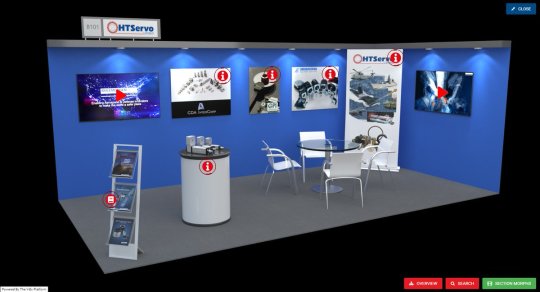
(1)Advantages and disadvantage of virtual exhibition:
Advantages:
1. It’s green:
Virtual exhibition eliminate the transport of artifacts and materials, which could reduce the carbon footprint of an event and also save big money for other good use.
2. It’s time-saving and long-lasting:
Virtual exhibition not only allow visitors to save time on travel, many also keep the virtual space for a long time after the actual event as a long-term display platform.
3. It’s available for more visitors:
Digital strategy includes virtual tours to allow rural, interstate and international audiences to the exhibitions without regional restriction. Besides, since a virtual space has no boarder it could contain more guests as long as the server is stable
4.It’s easier to track visitors’ interest:
Digital platforms make it easy to record users’ data and provide the museum an overall assessment.
Disadvantages:
1. It’s not exactly exciting:
With virtual exhibition, the audience doesn’t have all the excitement that goes along with a live event, so they’re not necessarily as engaged. The point is the curator has to work harder to catch the attention of attendees because they are not immersed in an atmosphere of enthusiasm and excitement as they are in a real space.
2. It’s technically vulnerable:
Virtual display may meet a lots of problems such as trouble connecting at the time of the show and page crash when overloading too many users…The museum needs to hire extra professional computer engineers to manage the online platform.
3. It’s relatively distracting:
When we’re attending an event in person, there is not many things to distract you. However, when we are visiting a museum online, it’s easier to get distracted by the web ads or other messages.
4. It’s not friendly to those who can’t afford a laptop:
(2) Examples of collections:
1.THE SOLOMON R. GUGGENHEIM MUSEUM:

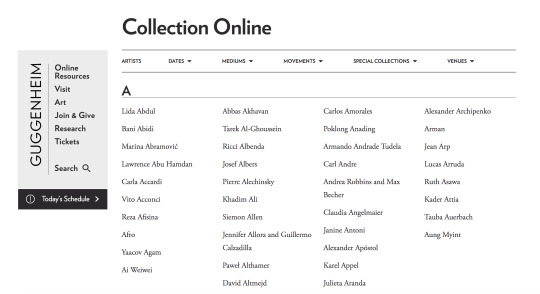
Advantages:
Rich Collections: Featuring over 1,700 artworks by more than 625 artists, the Collection Online presents a searchable database of selected artworks from the Guggenheim’s permanent collection of approximately 8,000 artworks. The selection reflects the breadth, diversity, and tenor of the Solomon R. Guggenheim Foundation’s extensive holdings from the late 19th century through the present day.
Detailed Searching Categories: The search engine is perfect and the visitors could easily find their favorite artworks divided by by artist, date, medium, movement, and venue.
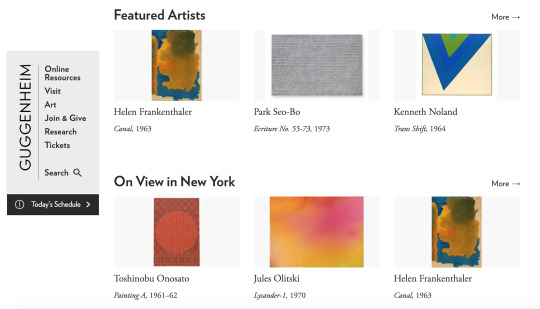
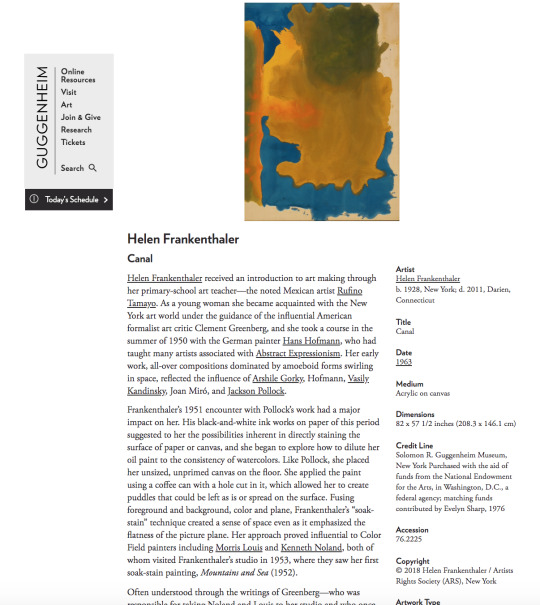
Disadvantages:
The online exhibition is only pictures with text description, and it is very difficult for visitors to immerse themselves in the virtual space since there is no where for them to explore. Personally, it makes me feel more like doing research or going through beautiful pictures rather than visiting a museum. Besides, the only medium is photography. There is no extra video, 3d maps or audio and to be honest it’s a little boring.
2.THE LOUVRE:
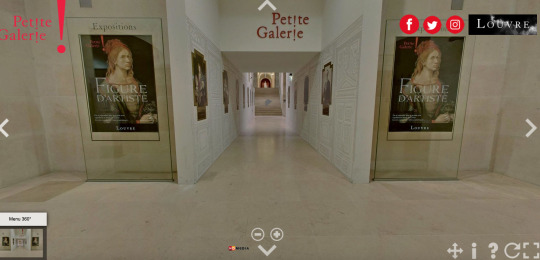
Advantages:
The excellent 3 dimensional map allows all online visitors to feel like they really engage in the collections since everybody could talk a virtual walk at the real museum.

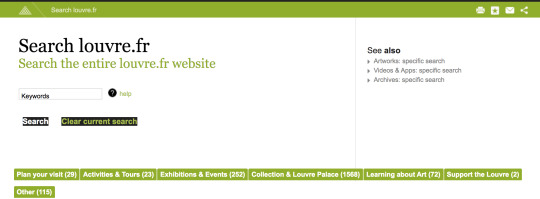
Disadvantages:
Poor web design: The visual effect of the website looks very outdated, like it was designed in the last century. On the contrary, GUGGENHEIM MUSEUM’s website is very clear, stylish and modern. Plus, the interface of the searching page is also a little bit unfriendly. There are only few categories and they are not that specific.
Lack of description: Although the 3d immersed map is very engaging and the viewer could click and zoom artifacts during the tour, there is no explanation of the displays when you click the work. It’s a single picture with no artist’s name and necessary information. It’s hard to leave an impression by just display a photo since the audience could not understand the purpose and the worldview behind it.
3.NASA:
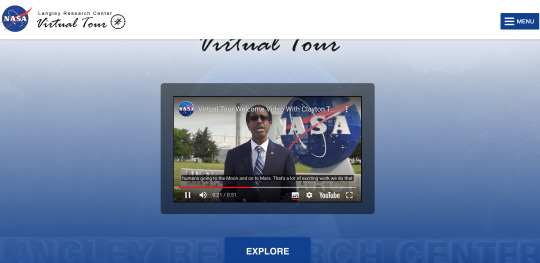

Advantages:
Vivid combination of text, picture and video provide the viewers with a relatively comprehensive understanding and it’s more interesting and attractive than boring text description.
Handy: The Space Center Houston also has an app that provides virtual tours, augmented reality experiences, and videos and audio stories about space exploration.
Disadvantages: Their web pages is loading at a very slow speed and occasionally suffer from freezing, which greatly affects the user experience. People usually browse the web very quickly, and an unsmooth experience will make the visitors impatient and less concentrated.
4.The Palace Museum:
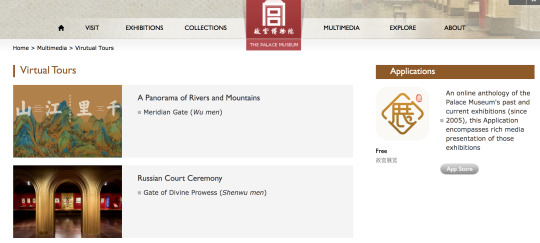
Assistance functions:

Advantages:
The online Palace Museum provides its visitors almost the best visiting experience they could achieve based on high technological support. Although it shares a similar 3d map with the LOUVRE, it has more assistant options to help their audience to engage in the collections, which include VR mode, full screen mode, automatic rotation (so that the visitors could follow the lead and won’t get lost ), related background music and detailed floor map.
Personally I like to hear matching background music when visiting the exhibition since it could help me relax and provoke some emotional feelings. So I’m very glad to find out that the curators of the Palace Museum considered that part and set a button so that those who prefer a quiet visiting time could also close the music and enjoy their time.
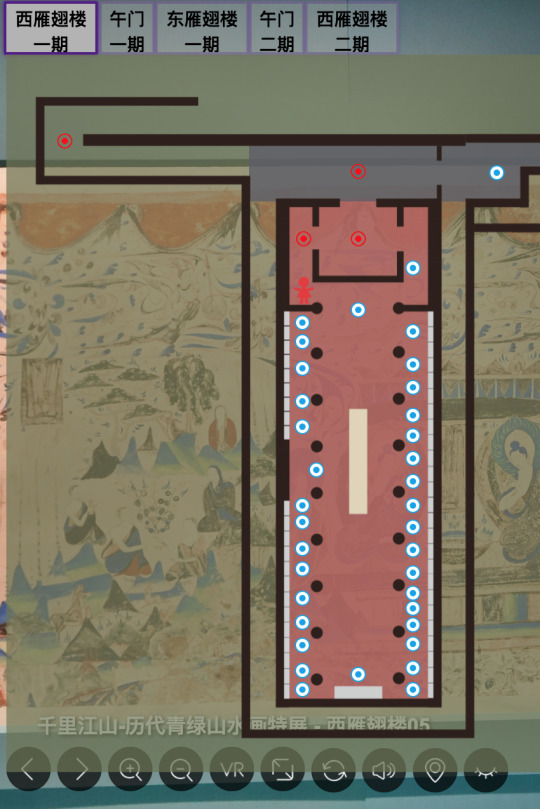
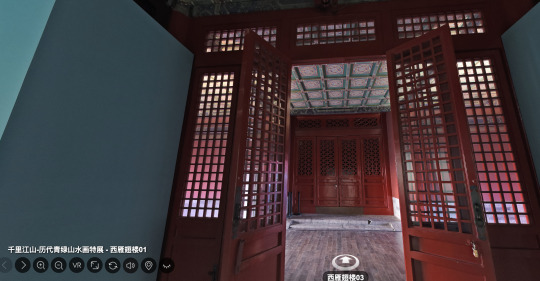
The rotation speed of the map is a bit fast, which can easily cause 3d dizziness.
Although the audiences can zoom in to view the introduction of exhibits, they cannot click on the specific artifact. Some paintings are in a really huge scale and it’s difficult for the audience to see the overall appearance of the work.

I think it’s better to combine the advantages of the Louvre with the Palace Museum that the viewer can not only zoom in to view the pictures, but also see the relevant notes.
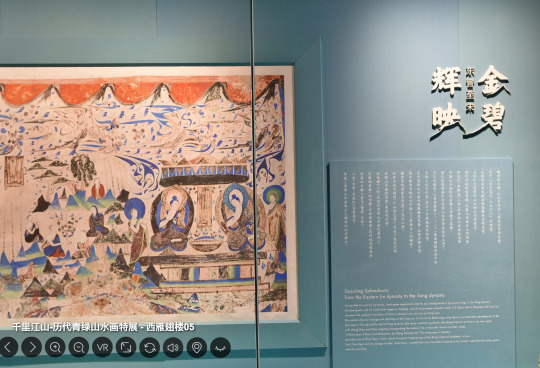
(3) Reading Reflection:
In Rodney’s opinion, it’s very different to appreciate the artifacts through its actual presence from experiencing it through the mediation of a screen (unless on purpose). Setting up in the physical environment, the audiences are more able to measure their own body against a display. The artwork could either remind them of some remarkable memories or some unforgettable experiences. Therefore, by occupying the same space and time, the visitors could create some special connection and meaningful memories with the displays and other viewers. In short, seeing art through screen does not allow the viewer to take his own measure and do no benefits for building up intimate relations to make visitors more engaged.
Ask questions of the work:
-The theme/purpose of the exhibition:
What is happening here? If the viewer could not find the answer during their visiting, it’s hard to provoke their further interest to investigate the artifacts. We need to communicate with them, to make ourselves present to the art even as it is present with us the moment we make visual contact.
“How did this come about? What kind of care had to be taken to make this thing? How long did this take and what else besides physical labor did it require of the maker?”
2. Imagine the worldview that brought the work about.
Each piece of work represents a world, however, not all of them have physical meanings. Thus, we should wonder about the author’s perspective as evidenced by the work. Is it ironic, celebratory, political or aspirational..etc. I think it’s significant for both the viewer and the creator to think about
whether or not they can live in the imaginary world. Are they welcomed? Who can live here and how can they thrive?
3. Look at yourself and ask what the work is calling up in you
A good artwork is in a conversation with the viewers and could provoke something. What specific emotional response is being called up and where did it come from? If you show some resistance in the interchange with a work of art and why?
4. Recognize the work’s agency
It’s highest respect to recognize that an artwork has its own entity rather than coextending with the author because it exceeds the artist’s hand and mind precisely when it comes into being in a different way for each viewer.
I really love what Rodney said that “Each work of art is like a clock that a watchmaker has given a ticking heart to and then let it go out to beat and beat and take breath and say with its own voice why it needs to be here with us now. ” A mature artifact has its own life and we should let it go when it’s been finished. However, before completing the last step, we need to question ourselves about its theme/purpose, its worldview and conversation like the essay discussed before.
0 notes
Text
week5
Mana Whenua Exhibition at Te PaPa

Theme/Purpose:
1. For those who do not quite understand Maori Culture, let them get a better knowledge and experience powerful stories that celebrate Maori as indigenous people of New Zealand, to explore the richness of Maori life and heritage through cultural treasures, oral histories, and contemporary art works.
2.For Maori people, to enhance their cultural self-esteem and self-confidence, showing that the country attaches great importance to the local Maori culture, and promote beneficial interactions between different cultures.
Exhibition: Encounter treasures handed down ranging from weaving, carving, and New Zealand greenstone pendants, to canoes and buildings.
Last year I went to the exhibition Mana Whenua (power from the land) to explore the colorful life of Māori people and their ancestors’ fabulous handcrafted heritage ranging from carving and weaving to canoes and buildings.Instead of simply displaying exhibits, the museum surprisingly made the entire exhibition area a treasure island where you are able to discover the hidden taonga yourself in such an interesting Māori context. By taking visitors on a stirring adventure, they teach through lively activities and immersive circumstance. The playful Mana Whenua Activity Trail helps you to think at the perspective of a Maori. For example, we know many different parts make up a marae (meeting place) , but where is the main exceptional meeting house? Should it located at the heart of the iwi tribe or emphasized by its dominant size? And If the meeting house is a official communal building, will food and drinks be allowed? Going through the game of trail, I was deeply moved by the planner’s great consideration and care. It needs rich knowledge reserve, actual experience and refined understanding of Māori culture to design such a wonderful exhibition.
Just as mentioned in the essay that “giving people control over their cultural heritage and its preservation as part of how they maintain, reinforce, or construct their identity. The approach acknowledges the importance of preserving not only resources that represent a community’s past, but also vital elements of its living culture and its continuing development (Kreps 2003)” Believing in the theory of biculturalism, Te PaPa lets the members of Māori culture speak for themselves and present their heritage in the most suitable way for audiences to appreciate. The practice of Mana Taonga helps to strengthen the confidence and self-esteem for communities from whence the artefacts originate from, most importantly, it results in a win-win situation for both the members and the outsiders by arousing aliveness and energy of cultures.
Work Cited
Kreps CF, Liberating Culture: Cross-cultural Perspectives on Museums, Curation, and Heritage Preservation. London & New York, 2003
0 notes
Text
week6
This week I read a very useful reading named “The Making of Exhibitions: Curators and Other Key Factors”, which talks about the key factors that contributes to a successful exhibition:
1). A well-organized exhibition that is able to arouse people’s interest;
2). A successful exhibition curation can strengthen the spectators’ knowledge base, sharpen their aesthetical comprehension and deepen their absorption of the intrinsic beauty of the real world;
3). A systematic-approach series exhibition is endowed with a coherent style that enhances the satisfaction of individual audience members in seeking knowledge and sentimental catharsis;
4). A thematic exhibition that aims for the targeted patrons may further develop potential audiences;
5). An exhibition is the best possible platform where knowledge is being shaped and exchanged;
6). An exhibition aptly imparts inspiration and exudes futuristic flavors and will never grow stale.
Besides, Chung (2015) sort through the bulk of the current literature before putting forward eight dimensions with regard to the success of an exhibition: the content of exhibition, expression and interpretation, marketing strategies, sales activities, information collection, the host’s ability to organize and prepare for the exhibition, resources management, and social circumstances, along with 34 indicators prophesying the success of exhibition.


0 notes
Text
Proposal Process
what might be in there for your project?
At first, I want to curate an exhibition about how people react during the covid-19 and quarantine time. Since I’ve felt quite sentimental and emotional in isolation, and lots of people shared about their similar feelings. Thus, I think it may not be a bad idea to choose a few exhibits that could remind the visitors about this special experience. When I was searching artists who devote to explore about human presence and the relationship between people and the space we are in, I found Antony Gormley, the British sculptor who is good at transporting visitors to “the threshold between the known and the unknown”.
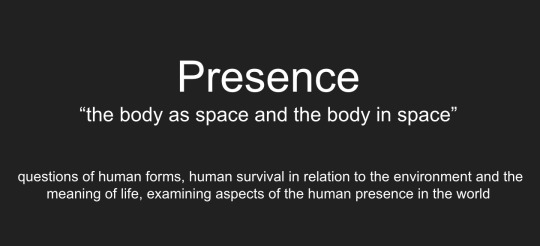
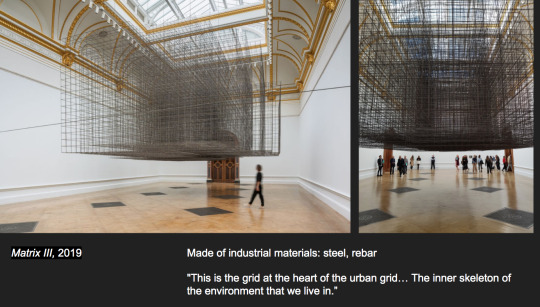


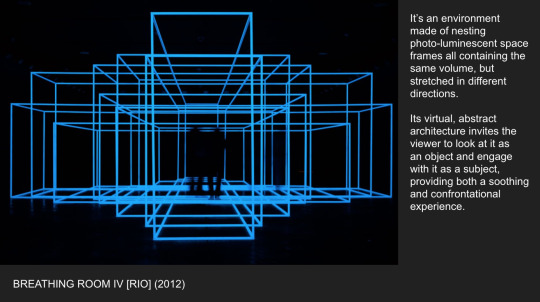
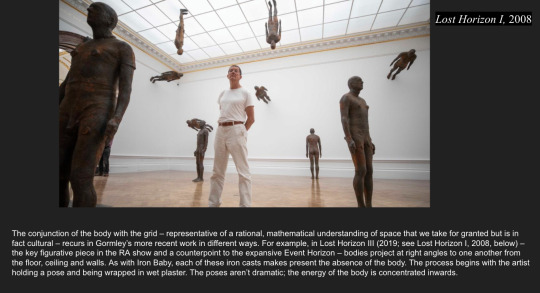
0 notes
Text
<1>Presentation Feedback:
There are a lots of useful feedbacks I’ve got from the presentation. Although my original thought is to curate an exhibition about to share your experience of that by a selection of art and installation that talk about being alone. However, loneliness isn’t the only one of the emotions that people feel toward coronavirus. The goal I want to achieve for this exhibition is to provides a platform for artists and creatives to visually capture this unprecedented time in our lives and express themselves in the way they know best, but it also offers a space from which people can draw hope and strength and realize they are not alone in this.
The artifacts on display shows all the feelings that pandemic brings: anxiety, scare, solitude, adamancy, courage and hope. There is the tedium of loneliness and isolated environments; the nervousness about bad news; the fear of infection and death and the struggles of frontline medical personnel… Through this exhibition, visitors will not only gain deeper insight into how people lived through the unprecedented difficult times, but also how they react and reflect towards it. It is not only an expression of individual daily life, but of emotions and introspection as well.
When suffering from negative emotions, people tend to question themselves and even wonder how others can stay optimistic. In fact, it’s natural to feel bad during hard times. Staying positive doesn’t mean you have to be happy all the time, it means when you see there are braver ones ahead and poorer ones suffering more, you know we must unite and fight together for better days.
“We think what people express through their artwork is an important testimony about the pandemic, because it gives you insight into how people lived through it, how they felt and how their reality has changed.”
<2>Recommended Resources:

Other than elements drawn from his previous works, Ai has came up with additional designs, too, which include details such as a surveillance camera, handcuffs and even creatures from ancient Chinese mythology. All of these masks were silk-screened by hand onto non-surgical cloth masks in Ai’s Berlin studio, and are non-washable and intended as artworks rather than medical use.
“Our small individual act becomes powerful when they are part of the social response. An individual wearing a mask makes a gesture; a society wearing masks combats a deadly virus. And a society that wears masks because of the choices of individuals, rather than because of the directive of authorities, can defy and withstand any force. No will is too small and no act too helpless,” the Chinese artist said of the initiative in a statement.

Man Pointing was made very rapidly for Giacometti’s first exhibition in New York. He recalled: ‘I did that piece in one night between midnight and nine the next morning. That is, I’d already done it, but I demolished it and did it all over again because the men from the foundry were coming to take it away. And when they got here, the plaster was still wet.’ It was originally intended to be part of a larger composition, with the left arm positioned loosely around a second figure. Giacometti later abandoned the idea, and considered Man Pointing to be a complete work.
0 notes
Text
Improvement target and newly selected items
With a further confirmation of my exhibition target——to provide a platform for visitors to visually capture this unprecedented time in our lives and to provide an immersive environment where they feel, review and reflect on these emotions. I decided to re-select a collection of artworks created during the covid-19. Because they are a real reflection of how people’ve reacted and felt about it. In addition, this new wave of pandemic art not only reflects the changing lifestyles during isolation but also shows the collective experiences that brought the world to a standstill. Therefore, by collecting artworks designed by artists and creatives during covid-19 and other installations that could assist us with better reflection, we curate a trendy, thoughtful yet interesting exhibition where visitors are able to soothe their own solidarity, see the common ground of people’s lives in quarantine, and draw closer to each other’s hearts again.
A new selection of possible exhibition items:
1. Untitled, Ai Weiwei, Face Mask Crafts, 2020:

2.Untitled, Karman Verdi, Photography, 2020 There are so many ghosts at my spot.

3.Untitled, Johanna Tordjman, Painting, 2020 During the quarantine, I watched the sky outside through Google Maps.

4.Untitled, pleasetalktomyhand, Photography, 2020 I really want to touch somebody.

5.Untitled, Yasinaribuga, Photography, 2020
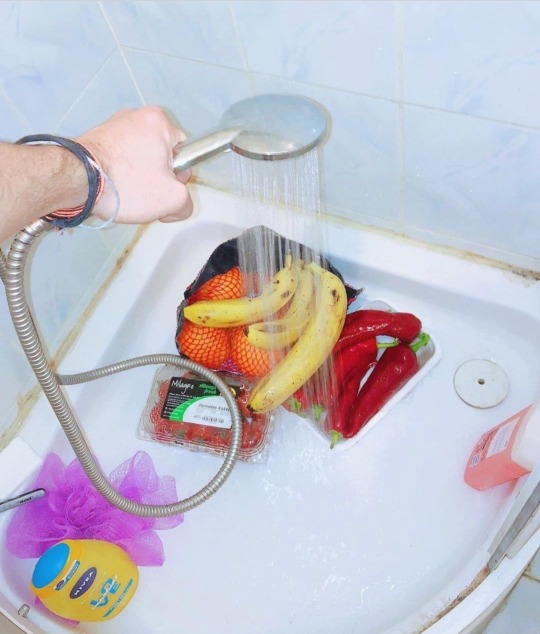
6.Untitled, Biel Aliño, Photography, 2020

7.Untitled, Ai Weiwei, Face Mask Crafts, 2020

0 notes